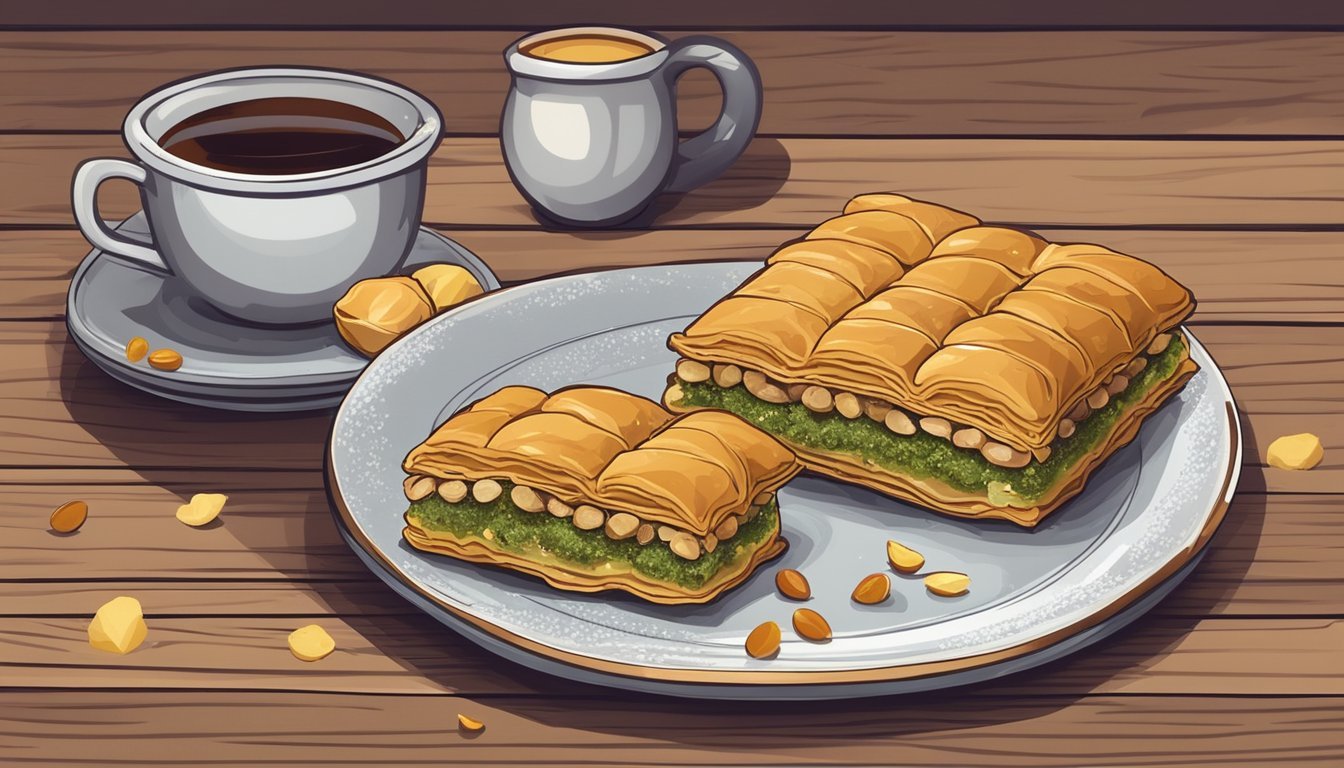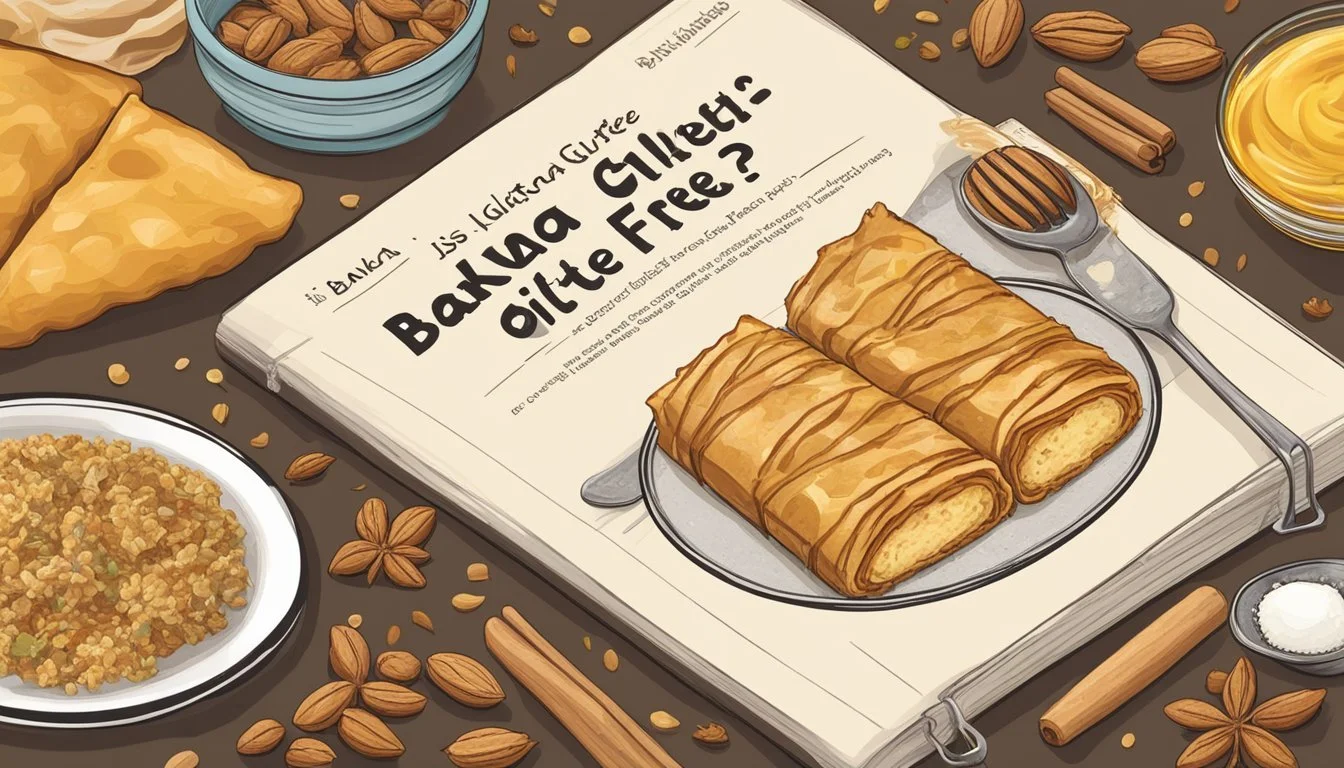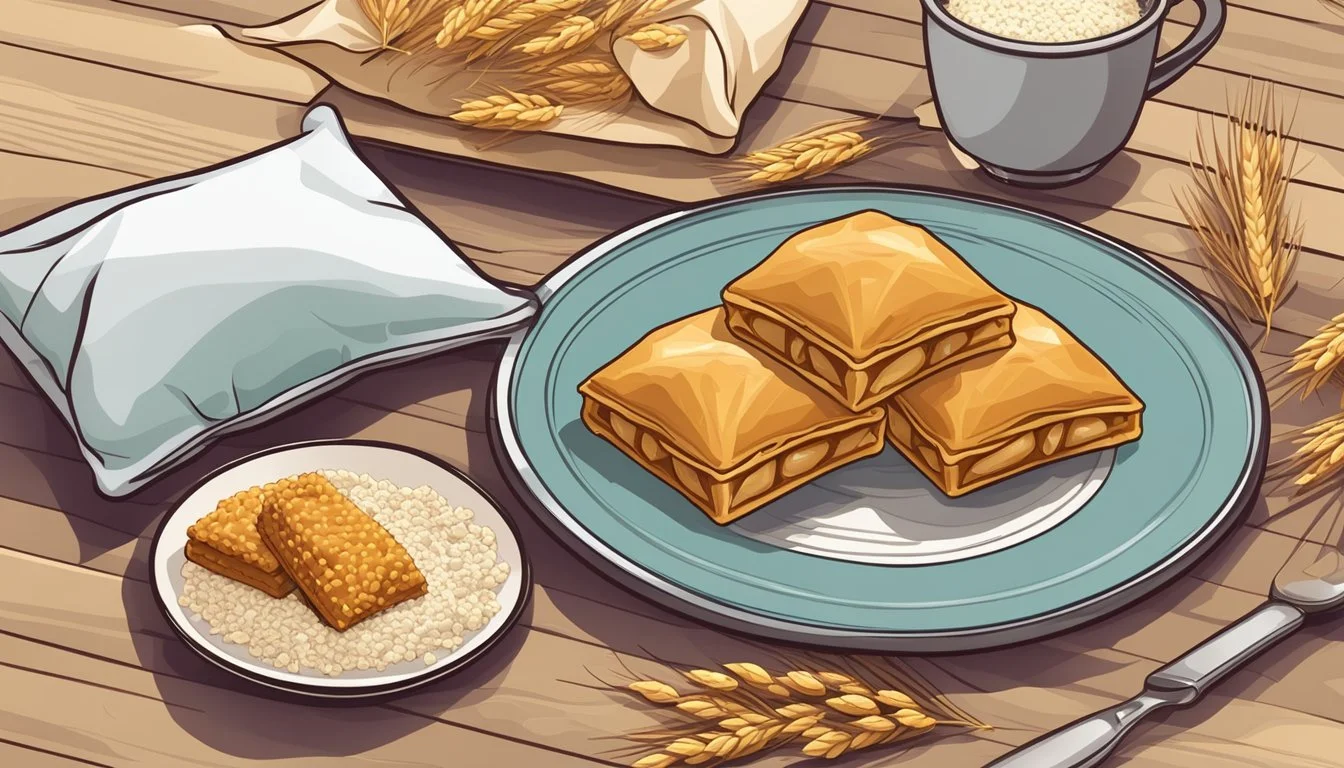Is Baklava Gluten-Free?
Understanding the Ingredients and Alternatives
Baklava, a rich, sweet pastry made of layers of filo filled with chopped nuts (What wine goes well with nuts?) and sweetened with syrup or honey, is a classic dessert (What wine goes well with desserts?) from the Mediterranean and Middle East. Its flaky texture and sweet taste have made it a beloved treat across the world. However, it might not be suitable for everyone's diet, particularly for those with gluten sensitivities or celiac disease.
Traditionally, baklava is not gluten-free because filo dough, the main ingredient used to create its delicate layers, is made with wheat flour. Wheat flour contains gluten, a protein that can cause reactions in individuals with gluten-related disorders. While the classic recipe calls for wheat-based filo, there are variations and alternatives that cater to a gluten-free diet.
The emergence of gluten-free alternatives has provided options for individuals seeking to enjoy baklava without gluten. Some specialty bakeries and stores now offer baklava made with gluten-free ingredients, ensuring that the dessert is accessible to those on a gluten-free diet. It's important, however, for consumers to verify the ingredients and preparation methods to ensure that the product is truly gluten-free, especially when cross-contamination is a concern.
What Is Baklava?
Baklava is a rich, sweet pastry that is a hallmark of Middle Eastern cuisine, with its roots often traced back to the Ottoman Empire. Layers of thin, flaky filo dough are meticulously crafted with a generous filling of chopped nuts, typically pistachios, walnuts, or almonds. The nuts provide a crunchy texture and a nutty flavor that contrasts beautifully with the delicate pastry layers.
The assembled layers are traditionally cut into an array of geometric shapes before baking. After baklava is baked to a golden perfection, it is drenched in sweet syrup made from sugar or honey, which absorbs into the filo, giving the dessert its hallmark sticky texture and sweetness. Lemon juice or rose water can be added to the syrup for additional flavor complexity.
Renowned for its indulgence, baklava serves as a staple dessert at many festive occasions and celebrations. Each region may boast its local twist on this classic treat, with variations in the type of nuts used, the composition of the syrup, and even the construction of the pastry layers. This dessert's historic and cultural significance is paralleled only by its popularity on the sweet tables of the world.
The Ingredients of Traditional Baklava
Traditional baklava is a rich, sweet pastry celebrated for its delicate layers, nutty filling, and aromatic syrup. Each component contributes to the dessert's highly regarded taste and texture.
Layers of Phyllo Dough
The foundation of baklava is phyllo dough, an unleavened dough known for its thin and flaky layers. It consists of flour—typically wheat—making the traditional baklava not suitable for a gluten-free diet.
Primary Ingredient: Wheat-based flour
Complementary Ingredient: Melted butter is liberally brushed between the layers to add richness and to help the layers crisp during baking.
Nut Filling
Baklava's filling features a hearty mix of finely chopped nuts. Common choices include:
Pistachios
Walnuts
Almonds
These nuts are often mixed with sugar and spices like cinnamon to enhance the overall flavor.
Sweet Syrup
The pastry is sweetened with a syrup that is poured over the layers after baking, allowing it to soak through the phyllo and bind with the nut filling. The syrup typically contains the following:
Sugar and water: Creating the syrup base.
Honey: Adds a rich, sticky sweetness.
Lemon juice: Provides a subtle tang, balancing the sweetness.
Flavor Enhancers: A cinnamon stick and occasionally cloves are infused into the syrup while it's being cooked to imbue a spiced aroma.
Understanding Gluten
In exploring the gluten content of foods, it's vital to understand what gluten is and which foods typically contain it. This knowledge is essential for individuals with celiac disease or gluten intolerance, as consuming gluten can lead to health issues for them.
What Is Gluten?
Gluten is a family of proteins predominantly found in wheat, barley, and rye. The two main proteins in gluten are glutenin and gliadin, with gliadin being responsible for most of the adverse health effects for those sensitive to gluten. When flour is mixed with water, these proteins form a sticky network that gives bread dough its elasticity and cakes their sponginess.
Foods That Contain Gluten
Many foods commonly contain gluten as it is derived from grains that are widely used in the food industry. Here is a list of food categories that often include gluten:
Baked Goods: Such as bread, pastries, cakes, and cookies.
Pasta: Wheat-based pasta like spaghetti and macaroni.
Cereals: Many breakfast cereals contain wheat or barley malt.
Snack Foods: Including crackers, pretzels, and granola bars.
Sauces and Gravies: Often thickened with wheat flour.
It's important to note that wheat flour, being a primary ingredient in many food products, is a major source of gluten. Individuals with conditions like celiac disease or gluten intolerance need to avoid gluten because it triggers harmful reactions in their bodies, damaging their small intestine or causing uncomfortable symptoms, respectively.
Is Traditional Baklava Gluten-Free?
Traditional baklava is a sweet dessert made with layers of phyllo dough, which is thin unleavened dough. The main concern for individuals with gluten sensitivity or celiac disease is that phyllo dough is typically made from wheat flour. Wheat flour contains gluten, a group of proteins found in wheat and other grains like barley and rye.
Because the essence of traditional baklava is the flaky layers created by the phyllo, substituting the wheat flour for gluten-free alternatives may affect the texture and taste. Those with celiac disease or gluten intolerance should be aware that consuming the traditional version of the dessert could lead to an adverse reaction due to the presence of gluten.
Here's a brief overview of traditional baklava ingredients:
Phyllo Dough: Made with wheat flour; contains gluten.
Nuts: Typically gluten-free; often includes pistachios, walnuts, or almonds.
Syrup: Usually a blend of sugar, water, and lemon juice; gluten-free.
Butter: Naturally gluten-free.
It is important for those requiring a gluten-free diet to either seek out certified gluten-free baklava or consider recipes that use gluten-free alternatives to phyllo. Specialty stores or bakeries might offer gluten-free versions, which should be prepared with strict cross-contamination measures to avoid any traces of gluten.
Ingredients for Gluten-Free Baklava
Crafting a delicious gluten-free baklava hinges on selecting the right ingredients that substitute traditional wheat-based components without compromising taste and texture.
Alternatives to Phyllo Dough
Traditional baklava relies on phyllo dough, which contains gluten. For a gluten-free version, bakers can utilize several alternatives to mimic the delicate layers that phyllo dough provides:
Rice Flour-Based Dough: A combination of rice flour and a binding agent like xanthan gum can create a similar texture to phyllo dough.
Nut Flour Creations: Nut flours, such as almond flour, can be used for their flavor and to introduce a different type of crispness to the pastry.
One should carefully balance these flours with other ingredients to achieve the desired consistency and to ensure that the baklava holds together well.
Gluten-Free Filling Options
The filling for gluten-free baklava typically consists of nuts and sweeteners, both of which are naturally gluten-free. However, ensuring that all other filling ingredients are safe for a gluten-free diet is crucial:
Nuts: Use finely chopped pistachios, walnuts, or almonds for authentic flavor and crunch.
Sweeteners: Combine sugar, honey, or agave nectar to create the characteristic baklava sweetness.
Additionally, spices like cinnamon and clove, as well as citrus elements like lemon juice, enhance the flavor profile without introducing gluten. As always, verifying that all ingredients are certified gluten-free helps prevent cross-contamination.
How to Make Gluten-Free Baklava
Crafting gluten-free baklava involves careful ingredient selection and preparation techniques to ensure the end result is as delightful as the traditional version. This section will guide through the process from choosing gluten-free ingredients to the final, sweet touch of honey syrup.
Choosing The Right Ingredients
The foundation to any gluten-free baklava is selecting the right gluten-free alternatives. For the gluten-free phyllo dough, look for specialty products that use gluten-free flours such as rice flour or tapioca starch. Ensure every ingredient, including nuts and sweeteners, is labeled gluten-free to prevent cross-contamination. Honey is naturally gluten-free and makes an ideal sweetener for the syrup, while cinnamon and cloves can be used for added flavor without any gluten concerns.
Gluten-Free Phyllo Dough: Check specialty stores or online.
Nuts: Walnuts, pistachios, and almonds are gluten-free.
Sweeteners: Use honey or certified gluten-free maple syrup.
Preparing the Gluten-Free Dough
While store-bought gluten-free phyllo dough can be used, one can also make it at home by combining gluten-free flours with xanthan gum to mimic the texture of traditional phyllo. The dough should be rolled out thinly and carefully handled to prevent tearing.
Homemade Phyllo: Mix gluten-free flours with xanthan gum for elasticity.
Rolling the Dough: Work gently to achieve a thin, pliable sheet suitable for layering.
Assembling the Layers
Begin by buttering a suitable baking dish with gluten-free butter. Layer the gluten-free phyllo sheets, brushing each with melted butter. Halfway through, spread the nut filling, a mixture of finely chopped gluten-free nuts like walnuts, pistachios, or almonds, combined with sugar and spices. Then, continue with more phyllo layers on top.
Butter the Dish: Prevent sticking and add flavor.
Phyllo Layering: Alternate sheets and melted butter.
Nut Filling: Combine chopped nuts, sugar, and spices.
Baking and Syrup Application
Bake the assembled baklava in a preheated oven until the pastry is crisp and golden. Meanwhile, prepare the honey syrup by boiling honey with a touch of lemon juice, water, and optional spices like cinnamon, letting it thicken slightly. Once the baklava is baked, pour the cooled syrup over the top, allowing it to absorb and add a delectable sweetness.
Baking Temperature: Preheat oven and monitor for a golden hue.
Honey Syrup: Create a fragrant and sweet infusion with honey and spices.
The resulting gluten-free baklava offers a delightful crunch with a sweet, nutty filling, all while catering to dietary needs without compromising on taste or texture.
Potential Challenges and Solutions
Adapting baklava for a gluten-free diet presents unique challenges. This section addresses ways to prevent cross-contamination, achieve the desired texture, and acquire suitable gluten-free ingredients.
Avoiding Cross-Contamination
One must be vigilant in ensuring that gluten-containing products do not come into contact with gluten-free baklava ingredients. This includes using separate kitchen tools and surfaces dedicated to gluten-free baking.
Kitchen tools: Use utensils, cutting boards, and bowls that are exclusively for gluten-free use.
Preparation surfaces: Thoroughly clean surfaces or use disposable liners when preparing gluten-free baklava.
Creating the Right Texture
Achieving the characteristic paper-thin layers of phyllo dough without the gluten structure is a challenge. One solution is to modify the ingredient ratios and employ alternative binding agents.
Ingredients: Combine gluten-free all-purpose flour with a binding agent like xanthan gum to mimic gluten's elasticity.
Technique: Handle the dough gently and roll it out as thinly as possible without causing tears.
Sourcing Gluten-Free Ingredients
Finding ingredients that are certified gluten-free is crucial for crafting a safe, gluten-free baklava. One should read labels diligently and possibly seek out specialty suppliers.
Phyllo Dough: Look for brands that specifically produce gluten-free phyllo dough.
Gluten-Free Certification: Ensure all ingredients, such as nuts and sweeteners, carry a gluten-free label.
Supplier checklist:
Ingredient Gluten-Free Label Supplier All-purpose flour Yes Gluten-Free Grocers Xanthan Gum Yes Baking Essentials Phyllo Dough Yes Specialized Brand XYZ Nuts (pistachios) Yes Organic Nut Haven Sweeteners (honey) Yes Trusted Beekeepers
Serving and Storing Gluten-Free Baklava
When serving and storing gluten-free baklava, one should consider the freshness and flavor preservation. Proper techniques can ensure that the dessert maintains its intended texture and taste.
How to Serve
Gluten-free baklava is best served at room temperature. The layers of the pastry should be crispy and flaky, with a moist filling that is neither too dry nor too soggy. It can be plated as individual diamond or square cuts, and a light drizzle of syrups, such as honey or a sugar-water mixture, can enhance the flavor. One may also garnish with finely chopped nuts to match the baklava's filling for added visual appeal and a complementary crunch.
Storing Tips
Short-Term:
Room Temperature: Store gluten-free baklava in an airtight container for up to 2 days. Keeping it on the counter prevents refrigeration's moisture from softening the layers.
Refrigeration: If storing for slightly longer, one can refrigerate the dessert, but it should be tightly wrapped to prevent it from absorbing other flavors and moisture from the fridge.
Long-Term:
Freezing: For longer storage, gluten-free baklava can be frozen. Wrap individual pieces or the entire portion tightly in plastic wrap, followed by aluminum foil before placing them in a freezer-safe bag or container.
Thawing: To serve, it's essential to thaw the baklava in the refrigerator overnight and then bring it to room temperature before serving to ensure it returns to its ideal texture.






